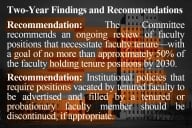You have /5 articles left.
Sign up for a free account or log in.

iStock/Getty Images Plus/oatawa
With layoffs, hiring freezes and challenges to faculty rights still happening across many campuses, some worry that COVID-19 is accelerating the decline of tenure. Notable exceptions include Ohio State and Syracuse Universities, which are pursuing ambitious tenure-track faculty hiring plans even as pandemic uncertainty remains.
Ohio State’s new president, Kristina Johnson, recently announced that the university plans on hiring at least 350 new tenure-track professors in the coming years. Syracuse University has already started hiring some 69 new tenure-track professors as part of a cluster hiring initiative. The university aims to have them all on campus within the next two years.
Such investments in the faculty demonstrate something about each institution’s -- and each institutional leader’s -- values. But certain conditions at both Syracuse and Ohio State make these investments viable, especially at this time. In each case, hiring plans are linked to the university’s research aspirations and diversity goals. Both Syracuse and Ohio State were also relatively well positioned financially going into the pandemic.
Ohio State
In her first State of the University address, last month, Johnson said that while Ohio State’s undergraduate enrollment grew by 5,800 students since 2008, the net number of tenure-track and tenured professors fell by 219 over the same period, to 2,827.
Now, she said, it’s time for a “new, strategic faculty hiring plan for tenure-track faculty -- and also one that appropriately values our associated, teaching and clinical faculty, many of whom are leaders in their fields.”
About 150 of these hires will be part of a new initiative called RAISE, short for race, inclusion and social equity, which was inspired by the university’s Task Force on Racism and Racial Inequities, Johnson said. At least 50 of these RAISE professors will be scientists, artists and scholars whose work addresses social equity and racial disparities in fields from health care and justice to education and the environment. Ohio State also hopes that some 100 of the RAISE professors will be underrepresented scholars, including scholars of color.
Speaking about representation, Johnson said, “This means a lot to me: as a young woman studying engineering in the 1970s, it took me a long time to realize that I could become a professor, because I never had a woman professor in any of my basic science, math or engineering coursework.” She added, “I want every single Ohio State student to be able to look across the lecture hall or seminar table and understand immediately that their dreams are valid and achievable.”
Noting that representation and diversity isn’t just about recruitment, Johnson said Ohio State “must also develop, encourage and retain our faculty.” To that end, the university will create hiring “cohorts” across individual colleges to foster networking.
Ultimately, Johnson said, “the RAISE initiative will bring to Ohio State researchers who develop new approaches to building an antiracist society, while changing the composition of our faculty and transforming our own culture, practices and policies so that Ohio State becomes an absolutely inclusive community.”
Beyond RAISE, Johnson said Ohio State will hire 150 scholars in high-demand fields where the campus student-faculty ratios exceed those of peer institutions, such as in business.
“If we can cap classes at 50 amidst all of the stresses of a pandemic,” Johnson said, “we can do it post-pandemic to personalize the education we offer.”
The last 50 hires will be faculty members in emerging fields of what Johnson called “leading-edge research, where Ohio State can and should be world-class -- and where we should, without question, be educating the next generation of leaders.” The university will provide “significant” start-up support for these professors’ labs and careers, she also said.
Ohio State’s provost, Bruce McPherson, previously announced that he is returning to the faculty in June. Johnson said that the next provost’s “most urgent priority” will be the faculty hiring plan.
Asked about how Ohio State will pay for its plan, university officials said those and other details are forthcoming, and underscored that executing the plan will be the priority of the next provost.
Simultaneously, Johnson announced a 10-year, $750 million investment in research and a plan to make undergraduate education debt-free.
Positive Reactions
Johnson’s plan seems to have been well received on campus, including by Don Pope-Davis, dean of the College of Education and Human Ecology. Pope-Davis, who has overseen successful diversity initiatives within the college, said Johnson’s plan “is an incredibly transformative opportunity, one that will impact and benefit the success of our students and community.”
Pope-Davis said 30 percent of faculty members within his college are now people of color, and that the new hiring boom will provide opportunities for further diversification, representation and inclusive excellence.
“We want our students of color to see their academic interests reflected in the composition of our faculty,” he said. “I want to build on the success we have had in recruiting and retaining talented scholars.”
Matthew Mayhew, William Ray and Marie Adamson Flesher Professor of Educational Administration at Ohio State, said, “As a faculty member, it’s exciting that the president has a vision for the university that involves hiring more peers. I think it’s fantastic, and I have to trust that somewhere someone has met with the budgeting folks about how to fund this decision before announcing it.”
Ohio State has some budgetary advantages, Mayhew said: its enrollment is growing and relatively little of its budget -- 11 percent -- is drawn from state funds. This makes it less vulnerable to fluctuations in the national and state economies stemming from crises such as COVID-19.
More than that, Mayhew said it’s “brilliant” how Johnson wove various initiatives together, namely equity and inclusion and a “huge commitment" to research.
“Increasing the funding for research increases the potential for jobs in the area,” Mayhew said, making a bold faculty hiring plan perhaps more attractive to the campus and off-campus community. “Listening to her message, I thought, ‘Wow, this is really a series of overlapping rings.’ … I don’t think she could accomplish as much without linking it all to the other components.”
To that point, Ohio State has also launched a $100 million strategic partnership with JobsOhio and Nationwide Children’s Hospital to spur innovation and economic growth, and the university has committed to increasing sponsored research in biomedical sciences and engineering by 50 percent and growing science programs over the next 15 years.
Gregory Price, professor of economics and finance at the University of New Orleans, said Ohio State can set these kinds of goals and accomplish them because “as one of our largest and most visible” public research-intensive universities, it has “the resources, mission and prestige to secure resources for faculty expansion.”
Syracuse
Syracuse is a smaller, private institution. But it, too, is thinking big about the faculty.
“We're taking the approach we're taking because it’s a competitive opportunity for us to attract top talent, and that includes diverse talent,” Kent Syverud, chancellor of Syracuse, said this week. “And we’re able to afford to do so because we'd been fiscally pretty careful going into the pandemic before it happened.”
Some three years ago, Syracuse adopted a joint cost-saving and fundraising program to generate $100 million for investment in strategic priorities. A good portion of that is now funding faculty hiring. That includes the cluster hiring program, which onboards small groups of faculty members working on the same or related topics across disciplines and even schools and colleges.
Announced in 2017 and since expanded, Syracuse’s cluster program includes group hires in the following areas: quantum information science; citizenship and democratic institutions; virtual and immersive interactions; and aging, health and neuroscience. Others are artificial intelligence, autonomous systems and the human-technology frontier, big data and data analytics, “BioInspired Syracuse,” the Institute for Material and Living Systems, energy and environment, and social differences and social justice.
Hiring was briefly paused at the beginning of pandemic but has since resumed.
“We believe that we’re hiring faculty where the world needs them,” Syverud said. “We have some real opportunities here and real demand for both research and education in some of these fields.”
He added, “We believe that if we build it, the students will come. And they are coming -- our applications are very strong.” How strong? Undergraduate applications are up 24 percent this year over last. Ph.D. applications are up, too.
Elsewhere, cluster hiring has been shown to support faculty diversity. To enhance the connection between cluster hiring and inclusive excellence and generally increase faculty diversity at Syracuse, the university has added financial incentives to schools and colleges.
In one case, the Diversity Opportunity Hires program provides a rotating fund to increase cost-sharing with the Office of Academic Affairs for recruiting underrepresented faculty members into any open position. This includes cluster hiring but isn’t limited to it.
Additional funding is being made available to support the hiring of underrepresented candidates into cluster positions. Typically, central funding made up half of a hire’s salary and benefits, with schools and colleges covering the rest. For underrepresented hires, central funding will cover 70 percent instead.
Syracuse has been under pressure to do more to support diversity and inclusion since 2019, when a series of racist and anti-Semitic incidents were reported on campus. Syracuse responded, in part, by committing to hiring a more diverse faculty. Syverud also said that diversity has long been central to Syracuse’s definition of excellence.
Tenure is part that definition, too.
“I believe in the tenure system,” Syverud said. “It’s produced the best higher education in the world. That’s why the world comes here. Tenure requires us to be rigorous in who we hire and who we promote, and if we do that, then tenure leads to innovation and independence with faculty going in all sorts of directions, bringing unexpected benefits.”









